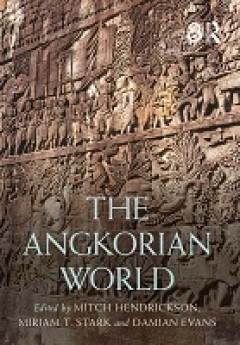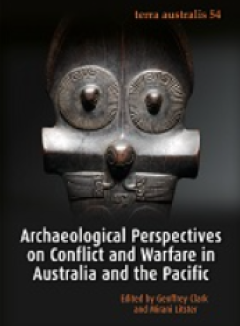Ditapis dengan

E-book Perspectives on the "Collapse" of Angkor and the Khmer Empire (Chapter…
The Angkorian World explores the history of Southeast Asia’s largest ancient state from the first to mid-second millennium CE. Chapters by leading scholars combine evidence from archaeology, texts, and the natural sciences to introduce the Angkorian state, describe its structure, and explain its persistence over more than six centuries. Comprehensive and accessible, this book will be an indis…
- Edisi
- -
- ISBN/ISSN
- 9780815355953
- Deskripsi Fisik
- 14 halaman
- Judul Seri
- -
- No. Panggil
- 930.1 EVA p

E-book Mainland Southeast Asia After Angkor: On the Legacies of Jayavarman VI…
This chapter will look beyond Cambodia as we know it today in geographic terms, and beyond the early 13th century, to highlight legacies of Angkor beyond Angkor on the Southeast Asian mainland (see Figure 32.1). To begin this exploration, allow me to point out the discreetly deceptive premises of this chapter’s title: that we all, author and readers alike, share established understandings of …
- Edisi
- -
- ISBN/ISSN
- 9780815355953
- Deskripsi Fisik
- 19 halaman
- Judul Seri
- -
- No. Panggil
- 930.1 THO m

E-book Antiquities: What Everyone Needs to Know®
The destruction of ancient monuments and artworks by the Taliban in Afghanistan and the Islamic State in Iraq and Syria has shocked observers worldwide. Yet iconoclastic erasures of the past date back at least to the mid-1300s BCE, during the Amarna Period of ancient Egypt's 18th dynasty. Far more damage to the past has been inflicted by natural disasters, looters, and public works. Art hist…
- Edisi
- -
- ISBN/ISSN
- 9780190614928
- Deskripsi Fisik
- 200 halaman
- Judul Seri
- -
- No. Panggil
- 930.1 AND a
E-book Modelling the Logistics of Mantzikert
The Battle of Mantzikert had profound consequences for both Byzantine and Turkish history, yet the historical sources for this campaign contain significant gaps. This book presents the results of a project that seeks to demonstrate the important role computer simulation can play in the analysis of pre-modern military logistics.
- Edisi
- -
- ISBN/ISSN
- 9781803278001
- Deskripsi Fisik
- 160 pages
- Judul Seri
- -
- No. Panggil
- 930.1 MUR m
E-book Frontiers of the Roman Empire: The Lower Danube Limes in Bulgaria
The inextricability of the connection between the Roman limes and the lands it ran through is easily observed and perfectly illustrated in Bulgaria. For a considerable distance it follows the Danube; both a major natural obstacle and at the same time a convenient communication route, it was easily defendable and facilitated control of trade routes.
- Edisi
- -
- ISBN/ISSN
- 9781803277806
- Deskripsi Fisik
- 96 pages
- Judul Seri
- -
- No. Panggil
- 930.1 DYC f
Ebook Gandharan Art and the Classical World: A Short Introduction
This book offers an introduction to Gandharan art and the mystery of its relationship with the Graeco-Roman world of the Mediterranean. It presents an accessible explanation of the ancient and modern contexts of Gandharan art, the state of scholarship on the subject, and guidance for further, in-depth study.
- Edisi
- -
- ISBN/ISSN
- 9781803276953
- Deskripsi Fisik
- 94 halaman, ilus.
- Judul Seri
- -
- No. Panggil
- 930.1

E-book The Future of the Bamiyan Buddha Statues : Heritage Reconstruction in …
Acts such as iconoclasm and biblioclasm have a long history in the world, whether committed during wartime, revolutions or times of repression, but the early twenty-first century has seen a new wave of deliberate destruction often publicly broadcast by the perpetrators. Recent prominent examples include the destruction of 16 tombs in Timbuktu, Mali, and damage to several World Heritage Sites in…
- Edisi
- -
- ISBN/ISSN
- 9783030513160
- Deskripsi Fisik
- 368 hlm
- Judul Seri
- -
- No. Panggil
- 930.1 NAG t

E-book Virtual Heritage : A Guide
While virtual heritage was initially described as a fusion of virtual reality (VR) technology with cultural heritage content (Addison 2001; Roussou 2002), as VR keeps changing, preservation of the content becomes increasingly problematic. Virtual heritage has been a (sometimes) successful communication medium but seldom has it succeeded as a preservation medium (Champion 2016).Even the term …
- Edisi
- -
- ISBN/ISSN
- 9781914481017
- Deskripsi Fisik
- 153 hlm
- Judul Seri
- -
- No. Panggil
- 930.1 MOL v

E-book Archaeological Perspectives on Conflict and Warfare in Australia and t…
Archaeological investigation of places marked by violence such as Ruapekapeka Pa? in northern New Zealand, where both European and Maori combatants died during significant military operations, has contributed to a national day of remembrance (R? Maumahara) to acknowledge that while colonial settlement played a significant role in modern nation-building, so did intrusion…
- Edisi
- -
- ISBN/ISSN
- 9781760464899
- Deskripsi Fisik
- 280 hlm
- Judul Seri
- -
- No. Panggil
- 930.194 AND a

E-book New Horizons for Asian Museums and Museology
In FY1994, Japan International Cooperation Agency (JICA) decided to hold a 6-month course called “Museum Management Technology (Collection, Conservation and Exhibition),” in which a then professor of Minpaku, Tsuneyuki Morita played a central role. Minpaku as an institution was commissioned to provide a 2-week “International Cooperation Seminar on Museology” as pa…
- Edisi
- -
- ISBN/ISSN
- 9789811008863
- Deskripsi Fisik
- 198 hlm
- Judul Seri
- -
- No. Panggil
- 930.1 SON n
 Karya Umum
Karya Umum  Filsafat
Filsafat  Agama
Agama  Ilmu-ilmu Sosial
Ilmu-ilmu Sosial  Bahasa
Bahasa  Ilmu-ilmu Murni
Ilmu-ilmu Murni  Ilmu-ilmu Terapan
Ilmu-ilmu Terapan  Kesenian, Hiburan, dan Olahraga
Kesenian, Hiburan, dan Olahraga  Kesusastraan
Kesusastraan  Geografi dan Sejarah
Geografi dan Sejarah